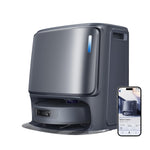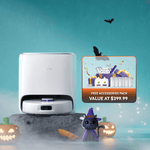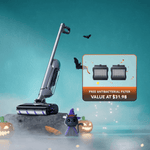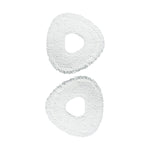Robot vacuums work by combining brushes, suction, and smart sensors to clean your floors automatically.
In this guide, we’ll break down exactly how they operate—from the way they lift dirt into a dustbin, to how they avoid walls, stairs, and furniture using built-in sensors. You’ll also learn how smart mapping allows them to navigate rooms logically, what internal components keep them running, and how these devices adapt to common Australian homes with mixed flooring and open spaces. We’ll finish with an honest look at the pros and cons, so you can decide if a robot vacuum is right for your daily cleaning routine.
Whether you’re curious about the tech behind them or considering your first purchase, this guide gives you a clear, expert-backed explanation of how robot vacuums actually work—and what to expect from today’s models like the Narwal Freo X Plus.
How Robot Vacuums Clean Your Home
Robot vacuums are designed to remove dirt, dust, and debris from your floors using a combination of spinning brushes, rolling brushes, and suction. At the heart of this process is the main brush located on the underside of the device. This rotating brush agitates and lifts dirt from both hard floors and low-pile carpets.
To help clean along edges and in corners, robot vacuums also use side brushes that sweep debris into the path of the main brush. Once the debris is centralized, a built-in vacuum motor sucks it into an onboard dustbin, which can be emptied manually or, in advanced models, automatically at the base station.
At Narwal, we’ve built our vacuums to handle more than just light cleaning. With powerful suction and an upgraded HEPA filter, models like the Freo X Plus can capture fine particles like pet hair, dust mites, and allergens—ideal for maintaining air quality in allergy-prone homes.
Lastly, the larger dustbin sizes in our latest models mean you can go longer between emptying, reducing daily upkeep while maintaining consistent cleaning performance.
How Robot Vacuums Move Around: Sensors Explained
Robot vacuums aren't just blindly roaming your home—they rely on a smart set of sensors to navigate efficiently and avoid common obstacles. These sensors allow the device to move smoothly around furniture, avoid stairs, and adapt to different room layouts, especially in open-plan homes common in Australia.
Most robot vacuums include bump sensors, which help them detect when they’ve hit an object like a chair leg or coffee table. When contact is made, the robot gently adjusts its direction and continues cleaning without causing damage.
To prevent falls, cliff sensors on the underside of the vacuum detect drops, such as staircases or ledges. These sensors send signals to stop movement when a sudden height difference is detected.
More advanced models—like the Narwal Freo X Plus—include wall-following sensors, which help the vacuum trace along the edges of your rooms. This ensures corners and skirting boards are cleaned thoroughly, an area many traditional vacuums miss.
And with wheel sensors, the vacuum tracks how far it’s traveled and when it needs to change direction. This helps create a more intelligent cleaning path, especially in larger areas or when navigating around common clutter like kids’ toys or pet bowls.
Whether you're cleaning a compact apartment or a sprawling family home, these smart sensors help your robot vacuum stay on track—so you don’t have to.
What Is Smart Mapping and Why It Matters

Modern robot vacuums don’t just wander around—they build a digital map of your home to clean more efficiently. This feature, known as smart mapping, allows your vacuum to understand where it has been and where it still needs to go.
[cta:narwal-freo-x-plus-robot-vacuum-and-mop]
Using laser sensors, advanced models like the Narwal Freo X Plus can scan your space, detect walls and furniture, and build a map in real time. This ensures no spot is missed and helps the vacuum clean in a logical, room-by-room pattern rather than randomly.
With smart mapping, your robot can remember your floor plan, making future cleaning sessions faster and more effective. If you live in a larger Australian home with multiple open areas, this means it can clean one zone at a time and return to its dock when the battery runs low—then resume where it left off after charging.
You can also control mapped areas via the app. For instance, you might want to send the vacuum just to the kitchen after breakfast or avoid a kids’ play zone during the day.
In short, smart mapping makes robot vacuums more intelligent, predictable, and user-friendly—helping them clean like you would, only hands-free.
[cta:narwal-freo-x-ultra-robot-vacuum-mop]
Key Components That Keep Robot Vacuums Running

A robot vacuum may look simple on the outside, but inside, it's packed with components working together to deliver consistent and efficient cleaning.
At the core are drive motors, which control the wheels and allow the vacuum to move across different floor types—from hard floors to low-pile carpets. Separate brush motors power the rotating brushes that sweep dust and debris into the vacuum’s suction path.
Sensors, as covered earlier, help the vacuum detect obstacles, edges, and walls. These are essential for navigation and safety, ensuring the vacuum avoids stairs and cleans efficiently around furniture.
Powering everything is a rechargeable lithium-ion battery, known for its long life and quick charging. For example, Narwal’s robots can operate for over 200 minutes on a single charge—more than enough to clean large Aussie homes in one go. When the battery runs low, the vacuum automatically returns to its charging dock and resumes cleaning where it left off.
This seamless combination of mobility, sensing, and power means less babysitting and more hands-free cleaning—whether it’s a small apartment or a multi-room house.
Robot Vacuums in Australian Homes: What to Expect

Australian homes come in all shapes and sizes, from compact apartments to sprawling open-plan houses. Many also feature a mix of hardwood floors, tiles, and area rugs, which can be challenging to clean consistently—but robot vacuums are built to adapt.
In cities like Sydney or Melbourne, where dust and pollen levels can be high and pets are common, robot vacuums with powerful suction and HEPA filtration help maintain cleaner air and reduce allergens indoors.
Open-plan living areas, often popular in Aussie homes, benefit from vacuums equipped with smart mapping and LiDAR navigation, which allow the device to understand large, unobstructed spaces and clean them without missing spots or repeating paths.
If your household includes children or pets, models like the Narwal Freo X Plus are particularly helpful. They automatically avoid toys, bowls, and clutter while maintaining a regular cleaning routine—even when you’re not home.
With their ability to handle various surfaces, minimise allergens, and clean large zones efficiently, robot vacuums are a practical fit for modern Australian living.
Pros and Cons: Are Robot Vacuums Worth It for Everyday Cleaning?
Robot vacuums offer great convenience, especially for everyday surface cleaning. But like any appliance, they come with both advantages and limitations. Here's what to consider:
Pros
-
Time-saving and hands-free: Set it and forget it. Perfect for busy Australians who want a tidy home without the hassle.
-
Consistent maintenance: Daily or scheduled runs keep dust, hair, and debris from piling up.
-
Smart features: Advanced models like Narwal Freo X Plus recharge automatically, map efficiently, and even resume cleaning where they left off.
-
Low maintenance: With larger dustbins and app control, it’s easier than ever to stay clean with minimal effort.
Cons
-
Not for deep cleaning: While great for daily upkeep, they might miss embedded dirt or grime that requires manual scrubbing.
-
Navigation limitations in cluttered spaces: In very complex layouts or where there are many small obstacles, occasional manual adjustments may be needed.
-
Still needs some maintenance: Even with auto-empty or self-cleaning bases, filters and brushes still need occasional attention.
For most households—especially those with pets, kids, or a busy lifestyle—a robot vacuum is a smart investment in everyday cleanliness. It may not replace your upright vacuum entirely, but it certainly reduces how often you’ll need to use it.
How does a robot vacuum know where to go?
Robot vacuums use a combination of sensors and mapping technologies to understand the layout of your home. Basic models use bump and cliff sensors to navigate, while advanced ones, like Narwal’s Freo X Plus, use laser mapping to plan efficient cleaning paths.
Do robot vacuums actually work on carpet?
Yes, most robot vacuums can clean low- to medium-pile carpets effectively. For deeper carpets, look for models with stronger suction and a central brush roller, which helps lift dirt from fabric. Narwal’s vacuums automatically adjust suction power based on surface type.
Do you need Wi-Fi for a robot vacuum to work?
Wi-Fi isn’t required for the vacuum to operate, but it unlocks additional features like app control, remote scheduling, map customization, and voice assistant integration. Without Wi-Fi, most models still clean, but you lose smart functionality.
Are robot vacuums worth it in Australia?
If you live in a busy household or have pets, robot vacuums are absolutely worth considering. They help manage daily messes and reduce the frequency of deep cleans. Especially in Australian homes with mixed flooring and open layouts, smart models can handle the job with minimal intervention.
The Bottom Line
Robot vacuums are a marvel of modern technology, combining advanced sensors, smart navigation, and efficient cleaning mechanisms to keep your home tidy with minimal effort. As technology continues to advance, these devices will only get better, promising even more convenience and smarter features in the future. If you haven’t yet considered adding a robot vacuum to your home, now might be the perfect time to explore this innovative solution. Contact us today to learn more about robot vacuum cleaners.










































